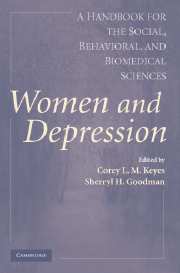Book contents
- Frontmatter
- Contents
- List of Contributors
- Foreword
- Preface
- PART I NOSOLOGY, MEASUREMENT, AND THE EPIDEMIOLOGY OF WOMEN AND DEPRESSION
- 1 Depression
- 2 The Epidemiology of Depression among Women
- PART II BIOLOGICAL, DEVELOPMENTAL, AND AGING MODELS OF RISK
- PART III COGNITIVE, EMOTIONAL, AND INTERPERSONAL MODELS OF RISK
- PART IV SOCIAL, POLITICAL, AND ECONOMIC MODELS OF RISK
- PART V SYSTEMS AND PROCESSES OF TREATMENT, PREVENTION, AND POLICY
- Author Index
- Subject Index
- References
1 - Depression
From Nosology to Global Burden
Published online by Cambridge University Press: 05 June 2012
- Frontmatter
- Contents
- List of Contributors
- Foreword
- Preface
- PART I NOSOLOGY, MEASUREMENT, AND THE EPIDEMIOLOGY OF WOMEN AND DEPRESSION
- 1 Depression
- 2 The Epidemiology of Depression among Women
- PART II BIOLOGICAL, DEVELOPMENTAL, AND AGING MODELS OF RISK
- PART III COGNITIVE, EMOTIONAL, AND INTERPERSONAL MODELS OF RISK
- PART IV SOCIAL, POLITICAL, AND ECONOMIC MODELS OF RISK
- PART V SYSTEMS AND PROCESSES OF TREATMENT, PREVENTION, AND POLICY
- Author Index
- Subject Index
- References
Summary
Depression is now identified as a major health issue, being a major cause of both psychological and physical morbidity. It is predicted to be second only to ischaemic heart disease in terms of total burden of disease burden to 2020 (Murray & Lopez, 1996). However, the definition of depression has undergone a number of changes over time, reflecting clinical and research fashions, evolving theories concerning psychological and biological causations of disease and the wider social context in which the problem is perceived. The changing fashions have affected how depression is viewed and how the construct is measured. This chapter will explore the evolving concepts involved in the nosology of depression, including a consideration of the implications for both genders.
MELANCHOLIA AND DEPRESSION
Melancholia has had much wider currency than depression through most of recorded history (Akiskal, 2000; Rush, 1986). The term referred to the presence of black bile associated with coldness, blackness, and dryness, so that melancholic individuals possessed a temperament that was essentially depressive. In a summary of Greco-Roman concepts, Akiskal (2000) noted the description of Soranus of Ephesus, in the second century bc, who characterised those with melancholia as exhibiting “mental anguish and distress, dejection, silence, animosity towards members of their household, sometimes a desire to live, and at other times a longing for death; suspicion that a plot is being hatched against him, weeping without reason, meaningless muttering, and occasional joviality.”
- Type
- Chapter
- Information
- Women and DepressionA Handbook for the Social, Behavioral, and Biomedical Sciences, pp. 3 - 21Publisher: Cambridge University PressPrint publication year: 2006
References
- 5
- Cited by



